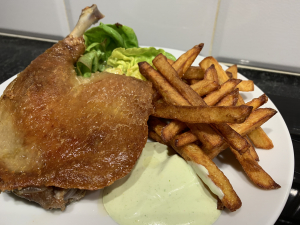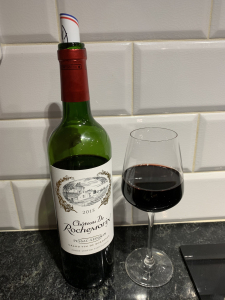
Confit is a technical cooking term, and also the past tense of the French verb “confire”, which means to cook something slowly with the goal of preserving it. Sugar, fat, salt, vinegar and eau de vie are the traditional materials used for preservation. Confiture is a derivation of this word (preserving fruits using sugar), but lemons can be confit in either salt or sugar (called preserved lemons). Duck legs (and other duck parts) are best confit in fat - duck fat preferred. For duck, the key is to keep the fat temperature low and to cook it over a long time – “low and slow”. (Note that a more modern definition of confit is to cook something slowly without necessarily the need to preserve it - think “tomate confite” or “l’oeuf confit”).
The first step of Duck Confit is to choose the right type of duck – it should be a “fatty duck”. Wild ducks are too lean and don’t do as well. The Mulard duck is the preferred variety when cooking by confit. For anyone interested in knowing, the Mulard duck is a sterile hybrid. It’s a cross between a female Pekin and a male Barbarie (red head). The male is chosen for its fat liver, and this is the same duck that provides “foie gras”. Now you know!
The second step of Duck Confit is to salt the meat overnight which serves to remove excess moisture and to add seasoning. The third step, the confit process, is very easy, although somewhat messy given all the grease involved!
Canning is altogether another technique and is not covered here. However, please know that preserving and canning duck (legs, liver, breast, gizzards, “cou farci”, etc) is a way of life here in the southwest of France. The farms that do this put out top notch products for sale at the local markets or boutiques. When you visit the region, think about picking up some cans as souvenirs. We’ve had guests send cans of duck and wine to their house address which made their subsequent travel easier, and allowed them to enjoy a taste of France back at home!
Ingredients – for 4 people
4 fatty duck legs
About 400g kg (1 lb) rock salt or kosher salt
About 1,5 kgs duck fat (3+ lbs.)
Cracked pepper, quantity desired
1 clove
Fresh thyme and/or rosemary, if available
- Salt the duck overnight.
- Pat dry the raw duck legs. Rub legs with half a garlic clove. Add salt to a flat container large enough to hold all 4 duck legs in a single layer. Mix salt with the pepper, clove and the garlic. Set aside about half of the salt (no need to measure). Place duck legs on the salt left in the Tupperware (skin side down), then place the herbs on the meaty side. Cover the top of this with remaining salt. You simply want to cover both sides of the legs with salt and seasonings. No need for precision here.
- Refrigerate, covered with a lid, for 24 hours to remove moisture.
- Before next step, rinse with cold water and pat dry.
- Cook the duck legs “low and slow”.
- Pre-heat oven to 70°C (160°F).
- Melt duck fat over low heat in a big oven-proof container large enough to submerge all 4 duck legs.
- Submerge the dried duck legs into warmed duck fat. Cover pan and cook in oven for up to about 4 hours. The duck fat temperature should not exceed the 70°C (160°F).
- Cook until done – which means that the meat is tender when pierced with a knife. The end of the leg bone might be visible (no skin left), and it should be tender.
- Let cool down in the duck fat.
- You’ll notice that the quantity of duck fat remaining in your pot after this process is greater than when you started!! The legs will shed some fat (but much still remains). You’ll also have some meat juice or gelatinous water (which can be used in sauces if not too salty).
NOTE: This is best done days before you want to serve the duck confit. Store cooked duck legs in the fridge, fully covered in fat. It will hold up to a week, otherwise they should be sterilized in jars/cans. When you are ready to serve, simply melt the fat and duck legs over low heat until you can easily pull out the legs without breaking off the skin. If using the duck legs in the immediate 24 hours following the confit process, then simply remove them from the fat and store, covered, in the fridge. CAUTION: this is a highly messy cooking process due to all the grease it involves!
- To serve the duck confit:
- Because the duck is already cooked, the only thing we have to do is crisp the skin and rewarm the meat.
- Warm up a non-stick pan or All-Clad style pan on medium-low heat. Place the duck legs skin side down in the pan and let crisp up, about 20 minutes. Rotate around until you get it crispy in as many places as possible! Do not cover pan as this will soften it. You may need to remove excess fat that is rendered during this process.
- Once skin is brown and crisp, turn over for 5 more minutes until hot inside. This can be done on the stove top or in a preheated oven at 200°C/400°F.
- Serve immediately with French fries and a green salad. I also like to add a dipping sauce for the fries, or mustard for the duck. Roasted garlic potatoes Sarladaise are also great with duck. Maybe this recipe will be forthcoming!

- With confit de canard, or duck in general, I always recommend a robust red wine. My preferred AOC is Péssac Léognan - it's my go to Bordeaux red. We paired this 2015 Château de Rochemorin with the duck confit, fries and salad. Délicieux! You can't go wrong with Pessac Léognan.
